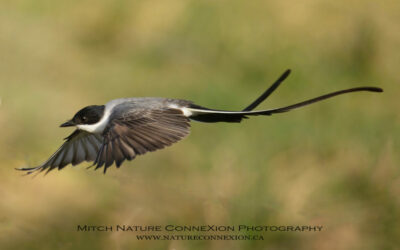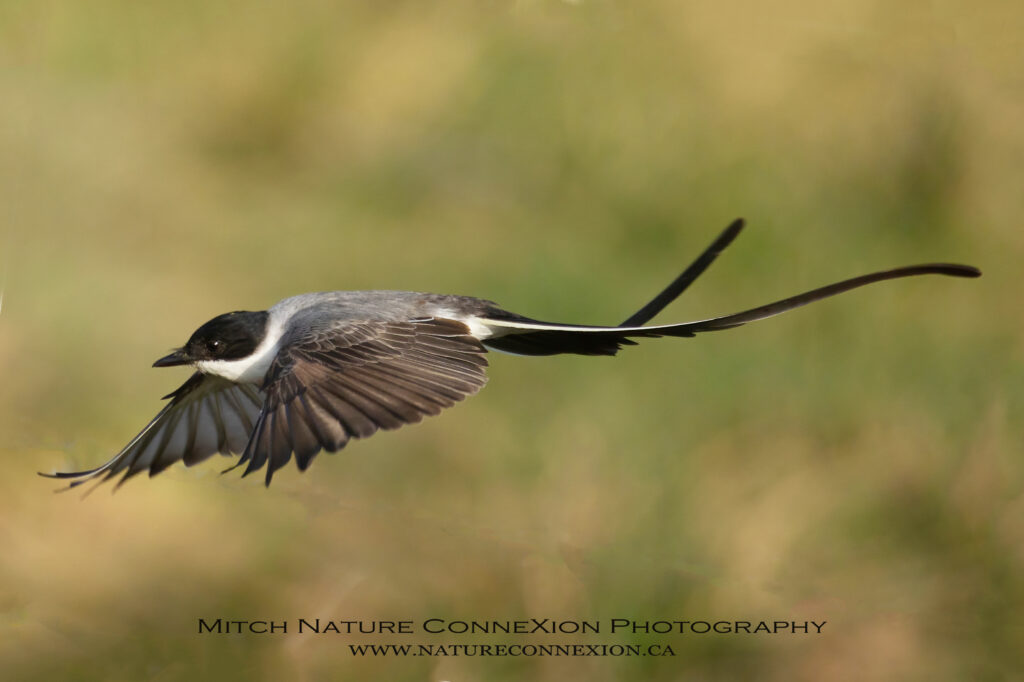
Fork-tailed Flycatcher
Tyrannus Savana (Daudin 1802) I liken this bird to a sky dancer. A lovely ballerina: a jeté here, a pirouette there, and balancing gracefully when perched with his impressive tail bobbing in the strong breeze…
In 1760, Maturin Jacques Brisson described this bird as “tyran à queue fourchue“ meaning fork-tailed tyrant. Later in 1780, Georges-Louis Buffon called it the savannah “le savana” because of its habitat. Finally, its binomial name was given in 1802 by François Marie Daudin: tyrannus savana (A great ruler or monarch of mixed woodland and grassland). For Mitch and I, this observation proved to be the most elusive for us. Many days were spent in nature and many more spent driving and searching to get to spots where this rare specimen had been seen. It has been reported every few years in New Brunswick. These long-distance rare migrants to the United States and especially to Canada are only seen when they navigate off course. In 2018-10-07, 08, we searched in Albert (Harvey Bank) driving one hour (60km) twice without luck after one was reported. Finally, in 2021-07-19 Mitch was able to observe this species. He made a round trip from Grand Manan alone to Memramcook and got to observe this lifer. He took the ferry Ferry and drove 2h20m/230km. We searched again for three days on 2021-11-21, 23 in and 25 in Queenstown driving 1h40m/160km without luck. Last week, 2023-10-26, 27 Mitch got to observe this beauty a second time after being spotted by Don Pellerin.He caught some beautiful photographs and video recordings of this majestic species. One image has him catching a dragonfly in mid-air! The next day, Mitch texted me from the field to tell me that it was still present at the same location. I decided to brave my pain and try my luck again. I finally got to observe this lifer for a brief moment as it sat on a barbed-wire fence where we were parked. What an amazing adventure! I could clearly see each feather with my binoculars although his eyes weren’t as clear as I hoped to see. Then he flew in front of the car on the dirt road fly-catching and landed right beside us on the fence! His eyes, feathers and behavior were clearly observed then. Ge was only interested in the insects hovering above him. The fork-tailed flycatcher is a passerine bird and a kingbird of the tyrant flycatcher family. It’s name comes from the strikingly lavish long forked tail that seems to be three or more times longer than his body. Including the tail, males are typically 37–41 cm (15–16 in) long and females are 28–30 cm (11–12 in). They weigh half as much as other kingbirds at 28–32 g (0.99–1.13 oz). Its white underside, grey back and black cap shone bright in the warm sun. Males sometimes show a yellow stripe on the crown. Juveniles and females display shorter tails but look the same as males. The bird we observed had a yellow streak on its crown and a long tail having the characteristics of an adult male. What a beauty! Owning up to his name as an insectivore feeding habits are primarily arthropods unless they are scarce. If so they will switch to berries and small fruit. Their lengthy tails allow for them to pivot and stop effortlessly during flight in order to follow and catch food. They can easily reach speeds up to 105 km/h (65 miles) but stay beneath 1000 m. Mr. Flycatcher steadied himself with the use of his tail by bobbing it up and down during wind gusts. He is a wanderer! Northern populations living in southern Mexico tend to be permanent residents. Fork-tailed flycatchers that live further south are migrants. Ours is likely from further south than Mexico. These migrating birds have more pointed wingtips than non migratory birds. They return to southern Mexico and past Argentina during migration. Known to be adventurous, they scatter everywhere: some staying on breeding grounds and others coming all the way into Canada up to New Brunswick where they are seen mostly during fall migration or fallouts. During migration times, their habitats and feeding grounds differ immensely from lightly forested areas, grasslands, shrub land, mangroves to riparian areas. They have adjusted to live in pastures and residential areas having trees and open areas also. They have been observed traveling with other kingbirds and to be aggressive to predators when in numbers. The flycatcher’s day consists of sitting, sallying, catching, and returning to their perch. Breeding areas include central Mexico and into central Argentina. They can nest in flocks of up to ten thousand birds. Males do amazing sky dancing and calls to impress females during breeding season from late summer to mid winter depending on where they live. Their nests are cup-liked, built where they feed and they prefer the Kielmeyera tree of Brazil for those that live there. Other trees selected are the Caribbean pine (Pinus caribaea), calabash (Crescentia cujete), craboo (Byrsonima crassifolia), and palmetto (Acoelorraphe wrightii). Materials used to build the nest are: twigs, grass and stems. The female works alone to incubate three to four eggs. The incubation period ranges from 10.0 to 13.5 days, and the nestling period ranges from 16.5 to 18 days. Nest height ranges from 0.4 meters (1.4 feet) to 9.6 meters(29.5 feet). The conservation status of this spectacular bird is of least concern. While in North America, they typically don’t vocalize. We did not hear any sounds or calls from this bird who tend to make a long sequence of tics, chips and buzzes during flight and breeding. It is said that they make a noise with their wings while in flight. Research of their flight noises is underway and interestingly may point to the fact that the use of these wing noises is to potentially startle predators or would-be nest parasites. There is a theory there may be a split between the migratory and non migrating groups due to the fact that their call is changing. The migratory birds calls are higher pitched. Their difference in wing shapes are another reason for this. Other researchers found that the eggs of migrating birds are more elongated than non migrating birds. Their study indicated that eggs that are round come from birds having rounded wings and oval shaped eggs were found in migrating birds having pointed wings and that this occurs generally for most birds. This is new exciting information for me. Being next to a lot of traffic as a group of men dropped off cows in a tiny enclosure, this flycatcher startled and lifted at times when a truck passed through. It didn’t mind people or cars stopping. Interesting facts about this species: The clade of this species is dinosauria. They have a 13.1 cm (15 inch) wingspan. They are vagrants to both Canada and the United States and do not breed in these areas. They have the longest most distinguishable tail compared to other birds. They live and perch in open areas. Little sky ballerina, you are a sight to behold! Until we meet again… For now we will need to move onto our next rare nemesis bird! Reminders: Project FeederWatch 2023 which is a joint research and education project of Birds Canada and the Cornell Lab of Ornithology is being held between November 1st to April 30th. Your ethical citizen bird observations are valuable! Your ethical citizen bird sightings matter and your observations make a huge impact! Consider making an account to document your observations on Ebird For rare sightings please contact Mitch who manages the rare birds for the province of New Brunswick on Ebird in the Historical NB Bird Records.
 Subscribe to Nature Connexion Blog & Newsletter
Subscribe to Nature Connexion Blog & Newsletter